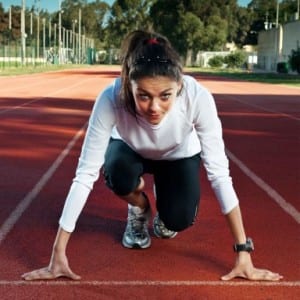New approach simplifies the physics of running, enabling scientists to predict ground force patterns; applies to rehab, shoe design and athletic performance.
Researchers at Southern Methodist University, Dallas, have developed a concise approach to understanding the mechanics of human running. The research has immediate application for running performance, injury prevention, rehab and the individualized design of running shoes, orthotics and prostheses. The work integrates classic physics and human anatomy to link the motion of individual runners to their patterns of force application on the ground – during jogging, sprinting and at all speeds in between.
Researchers at Southern Methodist University in Dallas have developed a concise new explanation for the basic mechanics involved in human running.
The approach offers direct insight into the determinants of running performance and injuries, and could enable the use of individualized gait patterns to optimize the design of shoes, orthoses and prostheses according to biomechanics experts Kenneth Clark , Laurence Ryan and Peter Weyand, who authored the new study.
The ground force-time patterns determine the body’s motion coming out of each step and therefore directly determine running performance. The impact portion of the pattern is also believed to be a critical factor for running injuries.
“The human body is mechanically complex, but our new study indicates that the pattern of force on the ground can be accurately understood from the motion of just two body parts,” said Clark, first author on the study and currently an assistant professor in the Department of Kinesiology at West Chester University in West Chester, Pennsylvania.
“The foot and the lower leg stop abruptly upon impact, and the rest of the body above the knee moves in a characteristic way,” Clark said. “This new simplified approach makes it possible to predict the entire pattern of force on the ground — from impact to toe-off — with very basic motion data.”
This new “two-mass model” from the SMU investigators substantially reduces the complexity of existing scientific explanations of the physics of running.
Existing explanations have generally relied upon relatively elaborate “multi-mass spring models” to explain the physics of running, but this approach is known to have significant limitations. These complex models were developed to evaluate rear-foot impacts at jogging speeds and only predict the early portion of the force pattern. In addition, they are less clearly linked to the human body itself. They typically divide the body into four or more masses and include numerous other variables that are hard to link to the actual parts of a human body.
The SMU model offers new insight by providing concise, accurate predictions of the ground force vs. time patterns throughout each instant of the contact period. It does so regardless of limb mechanics, foot-strike type and running speed.
“Our model inputs are limited to contact time on the ground, time in the air, and the motion of the ankle or lower limb. From three basic stride variables we are able to predict the full pattern of ground-force application,” said Ryan, who is a physicist and research engineer at SMU’s Locomotor Performance Laboratory.
“The approach opens up inexpensive ways to predict the ground reaction forces and tissue loading rates. Runners and other athletes can know the answer to the critical functional question of how they are contacting and applying force to the ground.” added Ryan.
Current methods for assessing patterns of ground force application require expensive in-ground force platforms or force treadmills. Additionally, the links between the motions of an athlete’s body parts and ground forces have previously been difficult to reduce to basic and accurate explanations.
The researchers describe their new two-mass model of the physics of running in the article, “A general relationship links gait mechanics and running ground reaction forces,” published in the Journal of Experimental Biology.
“From both a running performance and injury risk standpoint, many investigations over the last 15 years have focused on the link between limb motion and force application,” said Weyand, who is the director of SMU’s Locomotor Performance Laboratory. “We’re excited that this research can shed light on this basic relationship.”
Overall force-time pattern is the sum of two parts
Traditional scientific explanations of foot-ground forces have utilized different types of spring and mass models ranging from complex to very simple. However, the existing models have not been able to fully account for all of the variation present in the force-time patterns of different runners — particularly at speeds faster than jogging. Consequently, a comprehensive basis for assessing performance differences, injury risks and general running mechanics has not been previously available.
The SMU researchers explain that the basic concept of the new approach is relatively simple — a runner’s pattern of force application on the ground is due to the motion of two parts of the body: the lower portion of the leg that is contacting the ground, and the sum total of the rest of the body.
The force contributions of the two body parts are each predicted from their largely independent, respective motions during the foot-ground contact period. The two force contributions are then combined to predict the overall pattern. The final prediction relies only upon classical physics and a characteristic link between the force and motion for the two body parts.
New approach can be applied accurately and inexpensively
The application of the two-mass approach is direct and immediate.
“Scientists, clinicians and performance specialists can directly apply the new information using the predictive approach provided in the manuscript,” Clark said. “The new science is well-suited to assessing patterns of ground-force application by athletes on running tracks and in performance training centers.”
These capabilities have not been possible previously, much less in the inexpensive and accurate manner that the new approach allows for with existing technology.
“The only requirement is a quality high-speed camera or decent motion sensor and our force-motion algorithms,” Clark said. “It’s conceivable that even shoe stores would benefit by implementing basic treadmill assessments to guide footwear selection from customer’s gait mechanics using the approach.”
A critical breakthrough for the SMU researchers was recognition that the mass contribution of the lower leg did not vary for heel vs. forefoot strikes and was directly quantifiable. Their efforts lead them to recognize the initial force contribution results from the quick stopping of the lower part of the leg — the shin, ankle and foot — which all come down and stop together when the foot hits the ground.
Olympic sprinters were a clue to discovery
The SMU team discovered a general way to quantify the impact forces from the large impacts observed from Olympic-caliber sprinters. Like heel strikers, the patterns of Olympic sprinters exhibit a sharp rising edge peak that results from an abrupt deceleration of the foot and lower leg. However, sprinters accomplish this with forefoot impacts rather than the heel-first landing that most joggers use.
“The world-class sprinters gave us a big signal to figure out the critical determinants of the shape of the waveform,” said Weyand. “Without their big impact forces, we would probably have not been able to recognize that the ground-force patterns of all runners, regardless of their foot-strike mechanics and running speed, have two basic parts.”
When the researchers first began to analyze the seemingly complicated force waveform signals, they found that they were actually composed of two very simple overlapping waveforms, Ryan said.
“Our computer generated the best pattern predictions when the timing of the first waveform coincided with the high-speed video of the ankle stopping on impact. This was true to within a millisecond, every single time. And we did it hundreds of times,” he said. “So we knew we had a direct physical relationship between force and motion that provided a critical insight.”
New approach has potential to diagnose injury, rehab
The SMU team’s new concise waveforms potentially have diagnostic possibilities, Weyand said.
For example, a runner’s pre-injury waveforms could be compared to their post-injury and post-rehab waveforms.
“You could potentially identify the asymmetries of runners with tibial stress fractures, Achilles tendonitis or other injuries by comparing the force patterns of their injured and healthy legs,” he said.
And while medical images could suggest the injury has healed, their waveforms might tell a different story.
“The waveform patterns might show the athlete continues to run with less force on the injured limb. So it may offer an inexpensive diagnostic tool that was not previously available,” Weyand said.
Weyand is Glenn Simmons Professor of Applied Physiology and professor of biomechanics in the Department of Applied Physiology and Wellness in SMU’s Annette Caldwell Simmons School of Education and Human Development.






 Booming mobile-health app market needs robust FDA oversight to ensure consumer safety, confidence
Booming mobile-health app market needs robust FDA oversight to ensure consumer safety, confidence